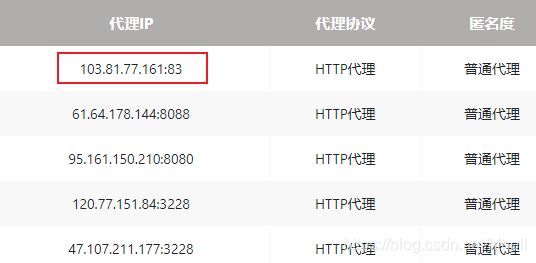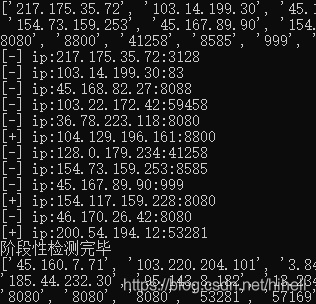很多爬虫大佬都会建立自己的,IP 代理池,你想知道 IP 代理池是如何创建的吗?如果你恰巧有此需求,欢迎阅读本文。
本案例为爬虫 120 例专栏中的一例,顾使用 requests + lxml 进行实现。
从 89IP 网开始
代理 IP 目标网站之一为:https://www.89ip.cn/index_1.html,首先编写随机返回 User-Agent 的函数,也可以将该函数的返回值设置为请求头,即 headers 参数。
def get_headers(): uas = [ "Mozilla/5.0 (compatible; Baiduspider/2.0; +http://www.baidu.com/search/spider.html)", "Mozilla/5.0 (compatible; Baiduspider-render/2.0; +http://www.baidu.com/search/spider.html)", "Baiduspider-image+(+http://www.baidu.com/search/spider.htm)", "Mozilla/5.0 (Windows NT 6.1; Win64; x64) AppleWebKit/537.36 (KHTML, like Gecko) Chrome/69.0.3497.81 YisouSpider/5.0 Safari/537.36", "Mozilla/5.0 (compatible; Googlebot/2.1; +http://www.google.com/bot.html)", "Mozilla/5.0 (compatible; Googlebot-Image/1.0; +http://www.google.com/bot.html)", "Sogou web spider/4.0(+http://www.sogou.com/docs/help/webmasters.htm#07)", "Sogou News Spider/4.0(+http://www.sogou.com/docs/help/webmasters.htm#07)", "Mozilla/5.0 (compatible; MSIE 9.0; Windows NT 6.1; Trident/5.0);", "Mozilla/5.0 (compatible; bingbot/2.0; +http://www.bing.com/bingbot.htm)", "Sosospider+(+http://help.soso.com/webspider.htm)", "Mozilla/5.0 (compatible; Yahoo! Slurp China; http://misc.yahoo.com.cn/help.html)" ] ua = random.choice(uas) headers = { "user-agent": ua, "referer": "https://www.baidu.com" } return headers
复制代码
上述代码中的 uas 变量,使用的是各大搜索引擎的 UA,后续案例将会继续扩展该列表字段,争取成为单独的模块。
列表随机选择一个值,使用 random.choice ,请提前导入 random 模块。
编写 requests 请求函数
提取公用的请求函数,便于后续扩展为多个代理站点采集数据。
def get_html(url): headers = get_headers() try: res = requests.get(url, headers=headers, timeout=5) return res.text except Exception as e: print("请求网址异常", e) return None
复制代码
上述代码首先调用 get_headers 函数,获取请求头,之后通过 requests 发起基本请求。
编写 89IP 网解析代码
下面的步骤分为两步,首先编写针对 89IP 网的提取代码,然后再对其进行公共函数提取。
提取部分代码如下
def ip89(): url = "https://www.89ip.cn/index_1.html" text = get_html(url) ip_xpath = '//tbody/tr/td[1]/text()' port_xpath = '//tbody/tr/td[2]/text()' # 待返回的IP与端口列表 ret = [] html = etree.HTML(text) ips = html.xpath(ip_xpath) ports = html.xpath(port_xpath) # 测试,正式运行删除本部分代码 print(ips,ports) ip_port = zip(ips, ports) for ip, port in ip_port:
item_dict = { "ip": ip.strip(), "port": port.strip() } ret.append(item_dict)
return ret
复制代码
上述代码首先获取网页响应,之后通过 lxml 进行序列化操作,即 etree.HTML(text),然后通过 xpath 语法进行数据提取,最后拼接成一个包含字典项的列表,进行返回。
其中解析部分可以进行提取,所以上述代码可以分割为两个部分。
# 代理IP网站源码获取部分def ip89(): url = "https://www.89ip.cn/index_1.html" text = get_html(url) ip_xpath = '//tbody/tr/td[1]/text()' port_xpath = '//tbody/tr/td[2]/text()' ret = format_html(text, ip_xpath, port_xpath) print(ret)
# HTML解析部分def format_html(text, ip_xpath, port_xpath): # 待返回的IP与端口列表 ret = [] html = etree.HTML(text) ips = html.xpath(ip_xpath) ports = html.xpath(port_xpath) # 测试,正式运行删除本部分代码 print(ips,ports) ip_port = zip(ips, ports) for ip, port in ip_port:
item_dict = { "ip": ip.strip(), # 防止出现 \n \t 等空格类字符 "port": port.strip() } ret.append(item_dict)
return ret
复制代码
测试代码,得到如下结果。
扩展其它代理 IP 地址
在 89IP 代理网代码编写完毕之后,就可以进行其它站点的扩展实现了,各站点扩展如下:
def ip66(): url = "http://www.66ip.cn/1.html" text = get_html(url) ip_xpath = '//table/tr[position()>1]/td[1]/text()' port_xpath = '//table/tr[position()>1]/td[2]/text()' ret = format_html(text, ip_xpath, port_xpath) print(ret)
def ip3366(): url = "https://proxy.ip3366.net/free/?action=china&page=1" text = get_html(url) ip_xpath = '//td[@data-title="IP"]/text()' port_xpath = '//td[@data-title="PORT"]/text()' ret = format_html(text, ip_xpath, port_xpath) print(ret)
def ip_huan(): url = "https://ip.ihuan.me/?page=b97827cc" text = get_html(url) ip_xpath = '//tbody/tr/td[1]/a/text()' port_xpath = '//tbody/tr/td[2]/text()' ret = format_html(text, ip_xpath, port_xpath) print(ret)
def ip_kuai(): url = "https://www.kuaidaili.com/free/inha/2/" text = get_html(url) ip_xpath = '//td[@data-title="IP"]/text()' port_xpath = '//td[@data-title="PORT"]/text()' ret = format_html(text, ip_xpath, port_xpath) print(ret)
def ip_jiangxi(): url = "https://ip.jiangxianli.com/?page=1" text = get_html(url) ip_xpath = '//tbody/tr[position()!=7]/td[1]/text()' port_xpath = '//tbody/tr[position()!=7]/td[2]/text()' ret = format_html(text, ip_xpath, port_xpath) print(ret)
def ip_kaixin(): url = "http://www.kxdaili.com/dailiip/1/1.html" text = get_html(url) ip_xpath = '//tbody/tr/td[1]/text()' port_xpath = '//tbody/tr/td[2]/text()' ret = format_html(text, ip_xpath, port_xpath) print(ret)
复制代码
可以看到,进行公共方法提取之后,各个站点之间的代码都十分相似,上述内容都是只提取了一页数据,扩展到其它页面,在后文实现,在这之前,需要先处理一个特殊的站点:http://www.nimadaili.com/putong/1/。
该代理站点与上述站点存在差异,即 IP 与端口在一个 td 单元格中,如下图所示:
需要针对该网站提供一个特殊的解析函数,如下所示,在代码中通过字符串分割进行 IP 与端口号的提取。
def ip_nima(): url = "http://www.nimadaili.com/putong/1/" text = get_html(url) ip_xpath = '//tbody/tr/td[1]/text()' ret = format_html_ext(text, ip_xpath) print(ret)
# 扩展HTML解析函数def format_html_ext(text, ip_xpath): # 待返回的IP与端口列表 ret = [] html = etree.HTML(text) ips = html.xpath(ip_xpath) print(ips) for ip in ips:
item_dict = { "ip": ip.split(":")[0], "port": ip.split(":")[1] } ret.append(item_dict)
return ret
复制代码
获取到的 IP 进行验证
获取到的 IP 进行可用性验证,并将可用 IP 存储到文件中。
检测方式有两种,代码分别如下:
import telnetlib
# 代理检测函数def check_ip_port(ip_port): for item in ip_port: ip = item["ip"] port = item["port"]
try: tn = telnetlib.Telnet(ip, port=port,timeout=2) except: print('[-] ip:{}:{}'.format(ip,port)) else: print('[+] ip:{}:{}'.format(ip,port)) with open('ipporxy.txt','a') as f: f.write(ip+':'+port+'\n') print("阶段性检测完毕")
def check_proxy(ip_port): for item in ip_port: ip = item["ip"] port = item["port"] url = 'https://api.ipify.org/?format=json' proxies= { "http":"http://{}:{}".format(ip,port), "https":"https://{}:{}".format(ip,port), } try: res = requests.get(url, proxies=proxies, timeout=3).json() if 'ip' in res: print(res['ip'])
except Exception as e: print(e)
复制代码
第一种是通过 telnetlib 模块的 Telnet 方法实现,第二种通过请求固定地址实现。
扩大 IP 检索量
上述所有的 IP 检测都是针对一页数据实现,接下来修改为多页数据。依旧拿 89IP 举例。
在该函数参数中新增加一个 pagesize 变量,然后使用循环实现即可。
def ip89(pagesize):
url_format = "https://www.89ip.cn/index_{}.html" for page in range(1,pagesize+1): url = url_format.format(page) text = get_html(url) ip_xpath = '//tbody/tr/td[1]/text()' port_xpath = '//tbody/tr/td[2]/text()' ret = format_html(text, ip_xpath, port_xpath) # 检测代理是否可用 check_ip_port(ret) # check_proxy(ret)
复制代码
此时代码运行得到如下结果:
上述代码,当 IP 可用时,已经对 IP 进行了存储。
with open('ipporxy.txt','a') as f: f.write(ip+':'+port+'\n')
复制代码















评论